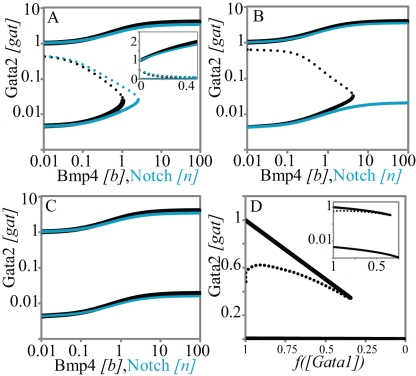Figure 2. Steady state signal-response analysis of the triad module to Notch, Bmp4 and Gata1 signals demonstrates irreversible bistability.
A. The action of Notch and Bmp4 at the promoters of switches the triad module from a low expression (OFF) state to a high expression (ON) state. Only Gata2 concentrations are shown for brevity. Solid lines represent stable and dotted lines represent unstable steady states. (Notch and Bmp4 concentrations are normalized by their respective binding affinities). Once the triad is in the ON state, the positive feedback loops in the modules architecture ensure that it remains in that state without signals (inset: the same plot in the linear scale). The switchability of the triad steady state response is sensitive to the values of  and
and  . In B and C, we use different values for these chromatin equilibrium constants and recalculate all free energy values using the analytical equations derived with experimental results. For
. In B and C, we use different values for these chromatin equilibrium constants and recalculate all free energy values using the analytical equations derived with experimental results. For  in B, only Bmp4 can switch the triad from OFF to ON. For
in B, only Bmp4 can switch the triad from OFF to ON. For  (C) neither Notch nor Bmp4 can switch the triad to ON state. D. Bistable response of the triad module to Gata1 repressor signal. Gata1 competes with Gata2 for binding sites on the Gata2-3 enhancer and can switch the triad from ON state to OFF by decreasing the recruitment of RNA polymerase to the Gata2 promoter by a factor
(C) neither Notch nor Bmp4 can switch the triad to ON state. D. Bistable response of the triad module to Gata1 repressor signal. Gata1 competes with Gata2 for binding sites on the Gata2-3 enhancer and can switch the triad from ON state to OFF by decreasing the recruitment of RNA polymerase to the Gata2 promoter by a factor  . As a result the system irreversibly switches from ON to OFF. (note that this figure is shown in linear scale, the inset shows the deactivation in log-log scale for comparison with A). To evaluate the steady state dose response of each signal individually the concentrations of other signals were kept fixed at zero during simulation.
. As a result the system irreversibly switches from ON to OFF. (note that this figure is shown in linear scale, the inset shows the deactivation in log-log scale for comparison with A). To evaluate the steady state dose response of each signal individually the concentrations of other signals were kept fixed at zero during simulation.

